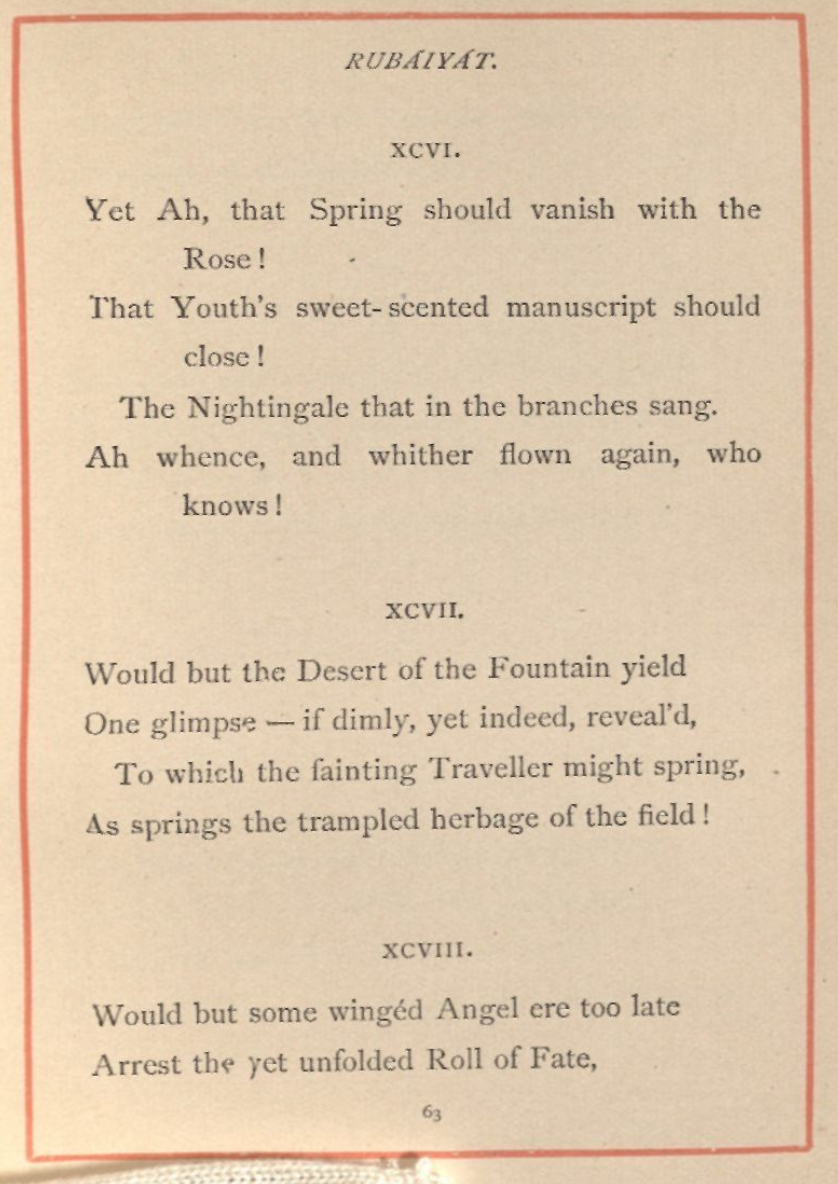Created by Amanda Younglund on Tue, 05/23/2023 - 18:19
Description:
For Christmas of 1888, “The Fair Lady Lucy” received a fourteenth American edition from Houghton, Mifflin & Co. titled Rubáiyát of Omar Khayyám: The Astronomer-Poet of Persia. This edition was published in 1888 and was printed in octavo format with two colors: black and red. The fourteenth edition used Edward FitzGerald’s 1879 (4th) edition of translation of the poem, still maintaining the biographical information on both Khayyám and FitzGerald and endnotes. While Lady Lucy’s copy did not come with any illustrations, Houghton, Mifflin & Co. did include an advertisement in the front matter for those who enjoyed the book enough to purchase a second copy with an “Ornamental Title-page and fifty-six magnificent full-page illustrations” by artist Elihu Vedder.
This edition has a simple binding design with a brown cloth covering and black and gold inset type and ornamental framing around the front. While this is the fourteenth edition of Houghton’s publication, it uses the same format and binding as the original printing of the James R. Osgood and Company from 1878, the first US trade edition. Osgood would shortly after sell his rights to Houghton and join their company, allowing Houghton, Mifflin & Co. to publish many editions of Khayyám’s Rubáiyát.
Worth noting is a printing error on page 63 within stanzas XCVII and VCVIII with several letters being warped on the left hand side of the page, most obviously on XCVII.4’s “As spring” and XCVIII.2’s “the yet.” This printing error occurs in the same place on Houghton, Mifflin, & Co.’s 1882 1st edition, but not the 1896 26th edition. It is likely the error occurred in editions 2-13 as well, but unknown when the error stopped appearing between editions 15-25. Errors such as these, especially when they are replicated precisely, are often the result of an error in stereotyping. Stereotyping, as well as the later electrotyping, involved casting a plate of a page of text for printing to be reused for future printings- often even future editions as well. An error in a stereotyped page would then appear in all copies of the edition, as well as other editions that used that same plate. Whenever this error was finally notice, a simple correction could have been made to fix it in which the errors would be cut out and replaced, meaning the rest of the original plate would still be able to be used. Houghton, Mifflin & Co. was no stranger to printing errors such as these, such as in the case of their reprinting of Nathaniel Hawthorne’s The Scarlet Letter:
“...when Houghton Mifflin decided to publish a new edition of The Scarlet Letter in 1959, the Riverside Edition — which had been kept in print since 1883, partly by the use of duplicate plates — was checked for variants. Nearly 900 were found.” Riverside Press, where The Scarlet Letter errors were found, was the same press this edition of the Rubáiyát was printed at, indicating a pattern for this location’s typography.
Fleishman, Glenn. “Reading the Reprintings: The Printer’s Side.” Medium, 21 Jan. 2022, glennf.medium.com/reading-the-reprintings-the-printers-side-b80797522ec4.
Khayyám, Omar. Rubáiyát of Omar Khayyám: The Astronomer-Poet of Persia. Translated by Edward FitzGerald, 14th ed., Boston, MA, Houghton, Mifflin & Co., 1888.


